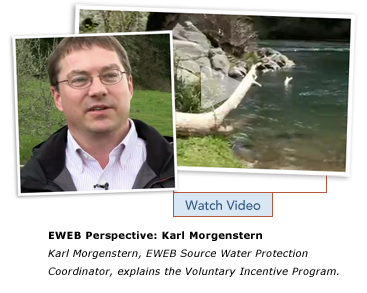Karl Morgenstern is EWEB's source water protection coordinator. Ask him about threats to the McKenzie River, and he can rattle off a startlingly long list with ease. “Threats to the McKenzie water supply range from tanker trucks carrying hazardous materials getting in accidents and spilling their loads, to industrial discharges, development on the river, septic systems, runoff of pesticides from agriculture and forest operations, urban runoff from East Springfield during storms from roads and parking lots.” He acknowledges that the list goes on.
Threats to the McKenzie River are, of course, serious business for EWEB and the 200,000 Eugene-area residents who rely solely on the McKenzie's water. If Morgenstern seems laid-back for someone whose job requires contemplating the conditions that would spell disaster for EWEB and its customers, it's because he knows all about the efforts EWEB undertakes to prevent or counteract even the slightest problems. A decade ago he helped to design EWEB's source water protection program and put it into action. He explains the approach as “a way to preserve something that you already have that's good. We have excellent water quality, and EWEB recognizes that it's important for us to try to keep that water quality for future generations.” Today's source water protection framework follows the initial one quite closely, but EWEB takes advantage of opportunities as they arise.
Recently EWEB developed the VIP to address the threats of increasing development and agricultural runoff, which are thought to have contributed to a measured decline in water quality over the past decade. Decreased water quality results in higher treatment costs for EWEB that get passed on to consumers. EWEB wants to promote preservation of healthy riparian areas in order to mitigate these threats. Promoting riparian areas is a good tactic because riparian areas filter pollutants from water before they enter the river, and keeping the river from becoming polluted costs less than treating polluted water later.
The VIP helps EWEB with risk management and cost avoidance, but as a novel approach it may not be readily accepted by all in the watershed. A number of concepts may help some embrace the program. One of these is seeing EWEB as building living infrastructure -- relying on processes in the natural environment to provide services instead of attempting to replicate them through engineered solutions. Another is seeing EWEB as providing payments for ecosystem services, or financial incentives to landowners who manage their lands in ways that provide a service (in this case water filtration) through ecological function that benefits people.
For Morgenstern, the VIP can be explained more simply. It comes down to promoting models of good stewardship. “A lot of landowners up here believe they are good stewards and are trying to be good stewards, but what that means, this program really helps define,” he says. Providing examples of good stewardship that showcase healthy riparian forests and intact floodplains will help landowners understand that it's far more than just trying to keep chemicals out of the river.
Morgenstern wants landowners to feel motivated by the VIP to maintain the estimated 45 percent of the McKenzie's riparian areas that is currently intact. Looking ahead he envisions the program resulting in decreasing the pace of development in the river's riparian forests. He hopes the program will eventually lead to returning some degraded riparian areas to a healthy state.
Landowners, especially farmers who tend to own large stretches of riverside property, are the obvious beneficiaries of the VIP. Morgenstern thinks many more benefits, tangible and intangible, will be shared among EWEB customers and within the watershed community. The VIP is projected to lower costs to EWEB customers in the long term by heading off the rate increases that would accompany declining source water quality if treated through engineered solutions. The program will pull together many local organizations with complementary goals in protecting the watershed or promoting community development.
EWEB envisions the VIP, taken as a whole, making a positive, wide-reaching, long-term impact fundamentally supported by the relationship between EWEB and landowners. “I see this program as being a community-building and an education program that is really two-way,” Morgenstern says. “We learn and we benefit, and they learn and they benefit as landowners.”

